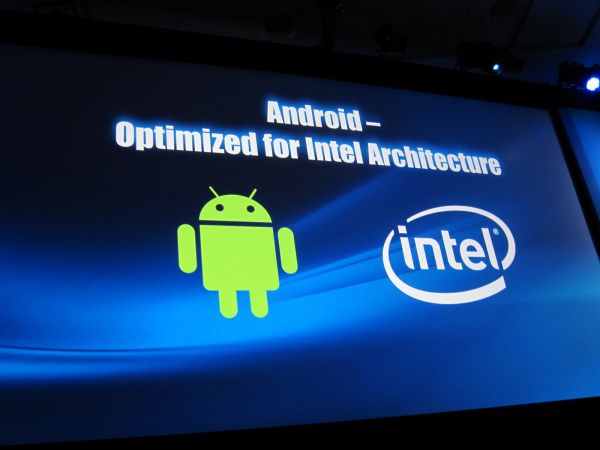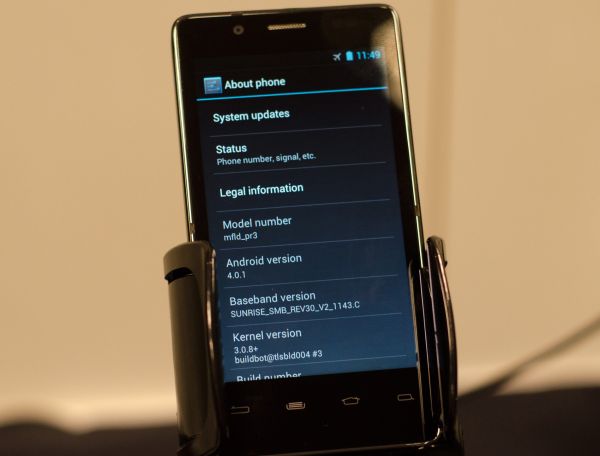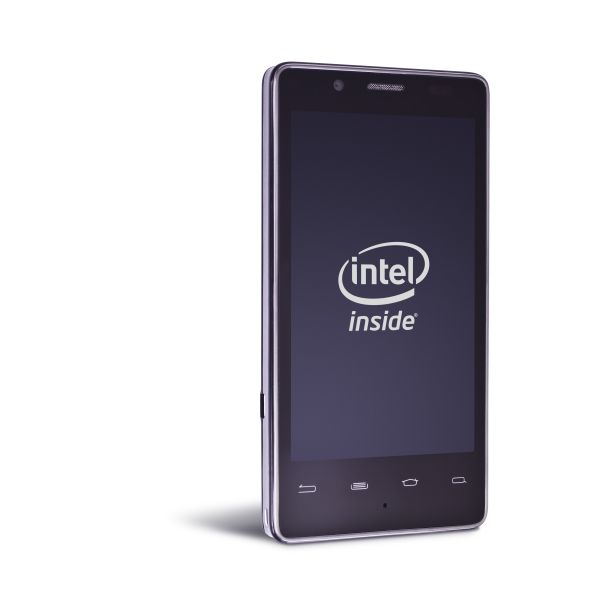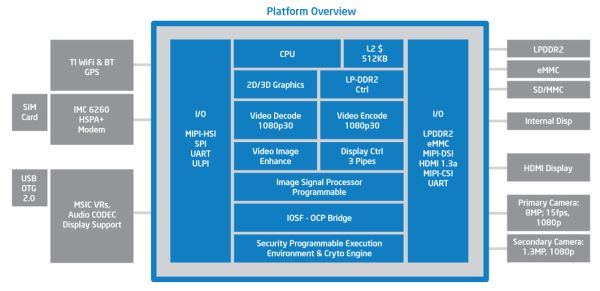Intel's Medfield & Atom Z2460 Arrive for Smartphones: It's Finally Here
by Anand Lal Shimpi on January 10, 2012 8:00 PM ESTWhat's Different This Time Around: Google & A Sweet Reference Platform
Intel has been talking about getting into smartphones for a couple of years now, but thus far it hasn't been able to secure a single design or partnership that that resulted in a product actually coming to market. This time around, things are different. The major change? Focus, and Google.
Intel originally had ambitions of enabling its own mobile OS with the help of Nokia (Moblin/MeeGo). Intel also wanted to support Android as well, however its attention was clearly more focused on the Moblin/MeeGo effort. Similar to the wake up call that pushed NVIDIA to focus exclusively on Android, Intel has now done the same.
At IDF last year Intel and Google announced a partnership and the intention to bring all future versions of Android, starting with Gingerbread, to x86. Since then Intel has ramped up the software engineering engine, going into the Android source code (Gingerbread, Honeycomb and now ICS) and fixing bugs. Intel's goal is to deliver the most stable version of Android as a result of its efforts. Intel is also submitting its changes upstream to the AOSP, which should help improve the Android experience even on ARM platforms.
Under the leadership of Mike Bell (formerly of Apple and Palm), Intel has also created an extremely polished Medfield reference design. This is the same design shown off at IDF last year (apparently there's an even thinner one floating around somewhere), but what separates it from other reference designs we've seen from SoC vendors is that the Medfield reference platform was designed to be a polished phone that could theoretically be rebranded and resold.
Intel knew the onus was on itself to prove that Medfield, Atom and even just x86 was power efficient enough to be delivered in a compelling form factor with competitive battery life. Paul Otellini gave Mike carte blanche access to any of Intel's resources. Instead of having to work with existing Intel groups, Mike was allowed to assemble his dream team of engineers. The team Mike built is what he felt he needed to not only bring Medfield to market, but also to build the a first class Atom based smartphone.
The result is this:
Internally it features Intel's own XMM 6260 HSPA+ modem. Intel claims LTE is on the way although there's no ETA on that.
WiFi in the reference design is provided by TI's 1283 controller. Intel's wireless team does not have a a WiFi solution that's low power enough to work in a smartphone, although after the recent restructuring the team has now been tasked with building an ultra low power solution that can.
The display is a somewhat unusual 1024 x 600 panel, with support for 1080p30 (and 1080i60) output via HDMI. The SoC specs are identical to what I've already discussed: 1.6GHz max CPU clock and a 400MHz GPU clock.
The reference platform is not only smartphone sized, but Intel has built its own qualification labs that mirror those of the carriers to ensure quality and convince its customers of the platform's legitimacy. In essence, Intel has built its own miniature smartphone design and test center.
The Medfield reference platform is available for use by any of Intel's customers, and indeed that's what's already happening. Lenovo's K800 is based on a modified version of Intel's reference platform, and I wouldn't be surprised if more aren't on the way.
All of this sounds a lot like Intel's efforts in the motherboard space over a decade ago where it started providing motherboard manufacturers with reference designs that they could modify if they desired. The effort helped significantly reduce time to market and allowed the motherboard makers to focus more on specializing on what they were good at.
The Medfield reference platform is designed to do the very same for smartphones. Intel wants to provide its partners with a well designed, stable smartphone platform. If they choose to use it, they can shave off a significant amount of development time and spend more of their time on software or simply bring a good reference phone to market in a quick fashion. I'm not entirely sure I've seen many players in the Android space that are actually all that great at software development, but Intel believes anything that shortens time to market will be appreciated.
I asked Intel if it has any plans to offer the reference platform unlocked, direct to customers. Unfortunately the answer at this point is still no. I suspect that Intel is more interested in building its customer base rather than circumventing it.
















164 Comments
View All Comments
extide - Wednesday, January 11, 2012 - link
Why does clockspeed matter? People should stop focusing on the clock so much. The real performance metric is performance per watt. Anyone remember the P4? How about Bulldozer? If intel can get more clockspeed in the same thermal envelope, then good job and they should be able to compare them side by side. I know ARM vendors would clock their chips faster, but then they run into thermal limitations.Wilco1 - Wednesday, January 11, 2012 - link
For single-threaded benchmarks clockspeed is the only thing that matters. I agree performance per watt is far more important in the real world. This is why dual or quad cores give better performance per watt than a single high clocked core. I don't believe ARM cores are thermally limited, Tegra 3 has 4 cores at 1.3GHz, and even faster SoCs are coming soon.milli - Thursday, January 12, 2012 - link
"For single-threaded benchmarks clockspeed is the only thing that matters"Ever heard of issue-width or instruction re-ordering? Ever heard of MIPS/Mhz? If you have, how can you say such a thing?
Wilco1 - Thursday, January 12, 2012 - link
IPC matters of course but only at similar frequencies. And frequency differences are typically much larger than IPC differences. For example 2-way out-of-order execution gives around 25% better IPC than 2-way in-order, however the frequency difference in the article is 33-60%. So given a large enough difference in frequency, you would expect an in-order to beat out-of-order.milli - Thursday, January 12, 2012 - link
You can't just paste performance numbers on a cpu based on it's high level architecture. Your example might be right for cpu A & B but you can't apply it just to every cpu.Next you'll tell me that a Cortex A15 is as fast clock for clock as a Phenom just because they are both 3-wide OoO architectures? Rest assured that a K10.5 core will be more than double as fast as an A15 (and i'm sure, up to 5-6x faster).
french toast - Thursday, January 12, 2012 - link
I can tell you now that cortex a15 wont be a million miles off clock for clock,even if it doesn't beat it.Obviously cache sizes/latency as well as bandwidth will play a part, but cortex a15 will be competitive with phenom, on a tiny fraction of the die space and power consumption.
cortex-a9 is nearly on par with a ULV core 2 duo clock for clock as difficult as that seems.
milli - Thursday, January 12, 2012 - link
Oh french toast, I've seen your comments here before. You just crack me up. Such a fanboi. I didn't even know there was such a thing as an ARM fanboi but you prove me wrong.FYI, an ULV C2D is around 3 to 10x faster than an A9 (clock for clock) and an A15 will get nowhere near a Phenom. Sorry to burst your bubble.
kaiyao - Wednesday, January 11, 2012 - link
While this chip for phones is finally out, does anyone know if Intel going to release any tablet chips anytime soon? Perhaps a dual/quad core version of this chip?Because Intel should really push out a chip competitive with ARM when Windows 8 comes out. I imagine if the chip performs as well as an ARM (in terms of performance and power efficiency), and if Intel matches the pricing of ARM chips, Windows 8 tablet manufacturers would definitely choose x86 over ARM to advertise compatibility with legacy applications.
I remember that the previous "mobile chip" from Intel did not work with Windows 7 due to something along the lines of the lack of PCI bus support, but since Microsoft can port Windows 8 to ARM, clearly this PCI bus is not an issue (if Microsoft modifies Win8 a bit). I presume application code will not be affected by the presence of the PCI bus.
guilmon19 - Wednesday, January 11, 2012 - link
I read somewhere, sorry i don't have a link, that intel was going to release a dual core version by the final quarterMumrik - Wednesday, January 11, 2012 - link
Page 4: "and I wouldn't be surprised if more aren't on the way."Isn't that the opposite of what you meant Anand?